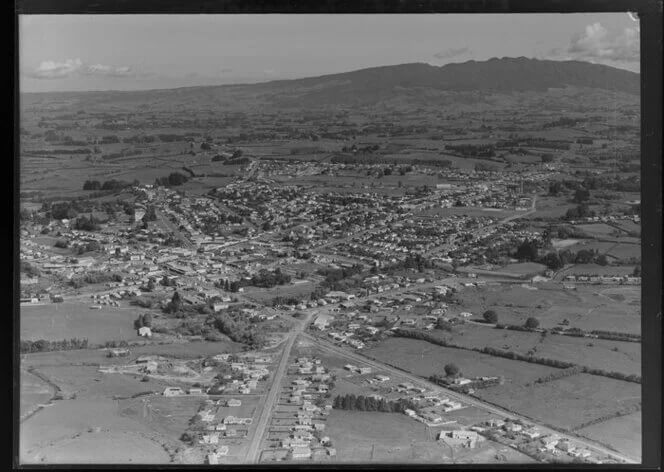Two of the luckiest men alive climbed unscathed from a pile of twisted wreckage after their Tiger Moth aircraft crashed on a hillside near Te Awamutu.

Te Awamutu 1964
The men came to grief during a flight from Te Kūiti to Rukuhia. The Tiger Moth ran out of fuel above Ōhaupō, lost height before the pilot could locate a suitable landing place and struck heavily near the top of a hill. It careered through two fences, one covered in a barberry hedge, slewed around, and came to rest in a paddock about 50 yards from the fence. It was smashed beyond repair.
A plum developed by a Ōhaupō orchardist, Mr Sage, was described in the fruit catalogue of the leading nursery firm in America as “the most delicious plum on earth.” The plum, known as the MacVerna, was named after Mr Sage’s two sons who were killed during the Second World War. The American firm of Stark Bros propagated the plum where it was met with a great response. Representatives of this firm stated that the plum from the Waikato was the finest variety since the world-famous Luther Burbank plum introduced during the first half of the century.
Mr Sage had 112 trees of the MacVerna plum in his orchard. He had sold several thousand trees since he propagated the new plum seven years previously after 40 years’ effort to produce an improved plum. Mr Sage also sent plum stock to both America and England and trees grew well in both countries. Stark Bros was so impressed with the plum that it purchased propagating rights from Mr Sage and took out patent rights for the fruit.
More than 2000 people lined Pirongia’s main street outside the little one-roomed library to watch a centennial pageant. The pageant ended in a re-enactment of the laying down of arms between King Tāwhiao and Major Gilbert Mair in 1881. The re-enactment was held on the spot where the two races first agreed to peace after the devastating Waikato wars. As the pageant progressed, from the arrival of the Tainui tribe to the peace ceremony, Māori women chanted welcomes, and the chants continued as Māori dignitaries ascended the steps of the library where Prince Mahuta Tūmate, representing King Korokī, unveiled a marble memorial plaque.
When acid was poured into a time clock at a Te Awamutu dairy factory it led to the fingerprinting of 14 workers out of 40 employees. Two of the 14 protested, so only 12 were finger-printed. The Federation of Labour objected saying the inherent law of British Justice assumed a man was innocent until he was proved guilty, whereas mass fingerprinting assumed people guilty until proven innocent. This method of deduction was not in line with the thinking of free and democratic people, said Mr Skinner, president of the federation. If a more serious crime had been committed in any other area would the residents have been mass fingerprinted? Mass fingerprinting was something the Federation of Labour would not agree to under any circumstances.








